Continuous Turbidity Monitoring Using Modified Sidestream Method
In a collaboration between YSI and the Miami Conservancy District in Southwest Ohio, the water quality of the Mad and Stillwater Rivers in the Dayton, Ohio, area is continuously monitored at gage stations (Figures 1a and 1b) using a sidestream method. The general measurement of turbidity in this “process-type” application correlates turbidity with conductivity during rainfall events.
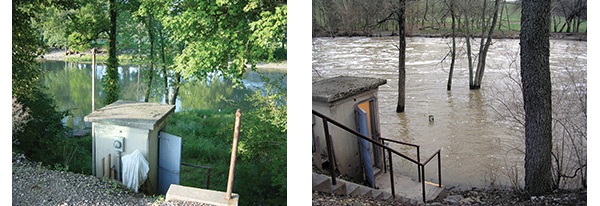
Figure 1a. Typical gage station for sidestream monitoring of rivers, during normal flow. Figure 1b. Gage station at high flow/high turbidity. Sidestream methodology prevents the water quality sensors from getting damaged during flood events.
Gage houses have been fitted with a vessel into which river water is pumped continuously and then discharged back into the river (Figure 2). The vessel is not sealed; instead, it uses a drain stem which assures that river water is not discharged until the vessel is full. This method allows the insertion of both the sampling filter of an automatic sampler and a multiparameter sonde, which contains sensors for temperature, conductivity, pH, dissolved oxygen, chlorophyll, blue-green algae, and turbidity.
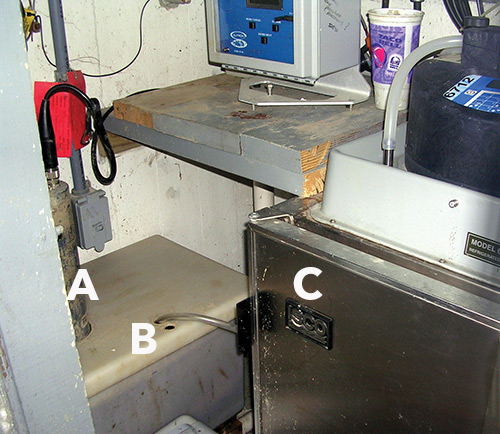
Figure 2. Contents of gage station, including A) sonde, B) sidestream vessel, C) auto sampler. Web-based data collection platform not shown.
Equipment
A YSI multiparameter monitoring sonde (such as our EXO2), with the above sensors, can easily acquire the data. For the turbidity studies, the sondes can be equipped with YSI turbidity sensors, which are automatically cleaned with a central wiper (EXO) or designated sensor wiper (6-series sondes) to remove bubbles and fouling prior to logging a data point (Figures 3 and 4). The wiper is activated within approximately one minute of recording data. The turbidity sensor is characterized by an optical system in which the angle between the emitted and detected radiation is approximately 90 degrees.
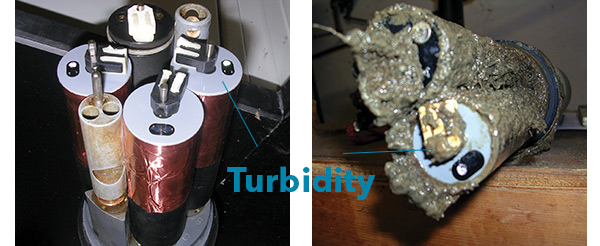
Figure 3. Sensors in sonde and Figure 4. Sediment fouling on sensors
In addition, the sensor uses an 860 nm near-infrared LED light source. These features (90 degree scatter and 860 nm radiation) are consistent with the recommendations of the International Standards Organization (ISO) 7027 method. The sondes are attached to a YSI web-based data collection platform (DCP) that is powered from AC outlets available in the gage houses. The sondes are in turn powered by the DCP via an SDI-12 interface. The DCP is set up to trigger sonde acquisition of data every one or two hours, depending on the site.
Typical Data
The data for the Stillwater River from the winter (Figure 5) is typical of that obtained during rainfall events. The data were acquired at a two-hour sample interval over about six months. Turbidity measured with the ISO 7027-type sensor correlates well with specific conductance. The correlation occurs because rainwater is effectively free of ions and lowers the conductivity of the overall river while it also washes sediment from fields contiguous to the river.
Because there is also continuous flow measurement (ft3/sec) at the site, the turbidity data could be combined with the flow to estimate sediment transport, particularly during rainfall events.
To do this, a turbidity reading in NTU is correlated to the amount of local sediment in mg/L present for that value of turbidity. (Learn more, Turbidity Measurements | Tips and Precautions). Usually, a good estimate for this geographic area is 1 NTU corresponds to about 1 mg/L, but clearly, this value will vary depending on the ground conditions. The sediment transport calculation has not been finalized at this time.
Sidestream methodology is likely reflective of the actual conditions in the river since the data for a sonde directly immersed in the river about five miles downstream from the gage station (Figure 6) have a very similar relationship of turbidity to conductivity.

Figure 5. Turbidity data from Stillwater and Figure 6. Turbidity data from Mad River
The entire multiparameter data file for one year of downstream monitoring is shown (Figure 7) for general reference and is reflective of the ability of these sensors to function for long periods of time with minimal maintenance.
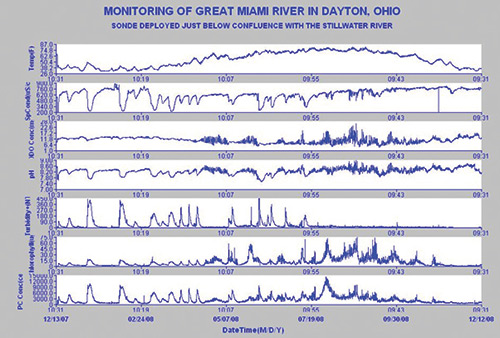
Figure 7. Long-term data with YSI sonde
Turbidity data for a rainfall event compares the intensity and temporal pattern of turbidity at different sites on the same river system. Both rivers flow into the Great Miami in downtown Dayton and together account for half the total flow of the Great Miami after the confluence.
The sharper turbidity pattern for the Mad River (Figure 8) is typical of most rainfall events in the region. The Mad is a smaller, more canalized river with high overall velocity. However, the additional turbidity events in the Stillwater after day 2 are likely due to localized rainfall in the watershed of this river, but not in that of the Mad. The main rivers are 20-30 miles apart in the upper regions of their respective watersheds.
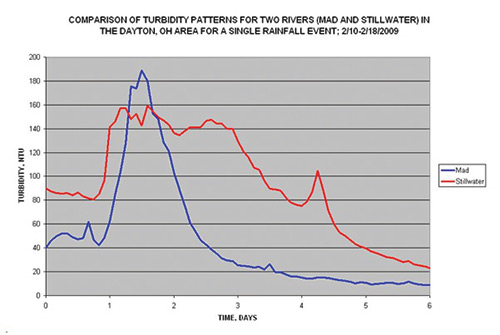
Figure 8. Turbidity comparison
Summary
Turbidity sensors of the ISO 7027-type design can provide high quality data in long-term studies when used in a process-style, sidestream application in which river water is pumped to a vessel which contains the turbidity sensor and then discharged back into the river.
When the turbidity sensor is attached to the proper data collection platform, the data are available in real time. A mechanically cleaned turbidity sensor may be necessary to obtain this type of continuous data since fouling is a common issue in river systems characterized by high turbidity events. As expected, the turbidity data show a good inverse correlation with the conductivity of the water because the rainwater which generates the high turbidity events has effectively zero ion content. Continuous logging of turbidity allows semi-quantitative comparison of patterns of sediment transport for different watersheds and, with the proper correlation of turbidity to suspended sediment concentration, will allow fairly accurate calculations of the total sediment transported.

Additional Blog Posts of Interest
5 Tips to Prevent Costly Mistakes With Your Sondes | Tip 1 of 5
The Evolution of Water Quality Monitoring {Free Ebook}
Webinar: Expert Tips for Continuous Water Quality | YSI, Aquatic Informatics and Pennsylvana DEP
Water Quality Monitoring Buoys Protect the Housatonic River | Application Note